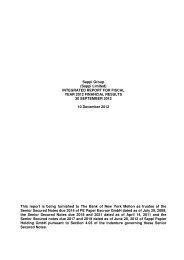2007 Annual Report - Sappi
2007 Annual Report - Sappi
2007 Annual Report - Sappi
You also want an ePaper? Increase the reach of your titles
YUMPU automatically turns print PDFs into web optimized ePapers that Google loves.
Notes to the group annual financial statements continued<br />
for the year ended September <strong>2007</strong><br />
35. Summary of differences between International Financial <strong>Report</strong>ing Standards<br />
and United States Generally Accepted Accounting Principles<br />
The group’s accounts are prepared in accordance with International Financial <strong>Report</strong>ing Standards, which differs in certain<br />
material respects from United States GAAP. These differences relate principally to the following items, and the effects on net<br />
profit and shareholders’ equity are shown in the following tables.<br />
International Financial <strong>Report</strong>ing<br />
Standards (IFRS)<br />
United States GAAP (US GAAP)<br />
a. Pension programmes and post- At 30 September <strong>2007</strong>, <strong>Sappi</strong> adopted FAS 158, ‘Employer’s Accounting for<br />
retirement medical benefits Defined Benefit Pension and Other Post-Retirement Plans’ as issued by the<br />
Financial Accounting Standards Board (FASB) in September 2006. The standard<br />
requires the net surplus or deficit of plans to be shown in the statement of<br />
financial position. The adoption of FAS 158 aligned the balance sheet<br />
presentation with IFRS. Upon adoption of FAS 158, all existing unrecognised prior<br />
service costs/credits are recognised in the Accumulated Other Comprehensive<br />
Income (AOCI). The prior service costs/credits recognised in the AOCI will<br />
continue to be amortised over the future life expectancy of the employees<br />
involved. The amortised amount will reduce the prior service cost/credit in the<br />
AOCI and will be accounted for in the net periodic benefit cost (NPBC).<br />
1. Transitional rules for On adoption of the revised IFRS Upon the first time adoption of US<br />
initial applications standard, IFRS requires the post- GAAP in 1996, the group had to<br />
employment obligation or asset to be amortise on a straight line basis the<br />
recognised immediately.<br />
original obligation over a number of<br />
years equal to the difference between:<br />
(a) the period from the effective date of<br />
the relevant US accounting standards<br />
to 1996; and (b) 15 years. Subsequent<br />
changes in the obligation or assets<br />
after initial adoption are recognised in<br />
the year in which the change occurs.<br />
In 2002, a pension asset was recognised for the Southern African defined benefit<br />
pension scheme as detailed below for IFRS and United States GAAP.<br />
2. Recognition of pension asset Post-employment benefit assets can No such limitation exists under<br />
only be recognised to the extent that US GAAP.<br />
the asset will lead to a reduction in<br />
future payments or a cash refund.<br />
The reduction in this asset is reflected<br />
in the Statement of Recognised<br />
Income and Expense.<br />
3. Recognition of curtailment In terms of IFRS, the difference The cumulative actuarial gains/losses<br />
gains and losses between the actuarial valuation and as well as prior service costs/credits<br />
the settlement or curtailment amount recognised in the AOCI that are no<br />
is recognised in the income statement. longer expected to be rendered will<br />
reduce the items recognised in the<br />
AOCI and will be accounted for in the<br />
income statement.<br />
160<br />
sappi limited | 07 | annual report
















